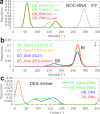Comprehensive Assessment of Force-Field Performance in Molecular Dynamics Simulations of DNA/RNA Hybrid Duplexes
- PMID: 39012172
- PMCID: PMC11325551
- DOI: 10.1021/acs.jctc.4c00601
Comprehensive Assessment of Force-Field Performance in Molecular Dynamics Simulations of DNA/RNA Hybrid Duplexes
Abstract
Mixed double helices formed by RNA and DNA strands, commonly referred to as hybrid duplexes or hybrids, are essential in biological processes like transcription and reverse transcription. They are also important for their applications in CRISPR gene editing and nanotechnology. Yet, despite their significance, the hybrid duplexes have been seldom modeled by atomistic molecular dynamics methodology, and there is no benchmark study systematically assessing the force-field performance. Here, we present an extensive benchmark study of polypurine tract (PPT) and Dickerson-Drew dodecamer hybrid duplexes using contemporary and commonly utilized pairwise additive and polarizable nucleic acid force fields. Our findings indicate that none of the available force-field choices accurately reproduces all the characteristic structural details of the hybrid duplexes. The AMBER force fields are unable to populate the C3'-endo (north) pucker of the DNA strand and underestimate inclination. The CHARMM force field accurately describes the C3'-endo pucker and inclination but shows base pair instability. The polarizable force fields struggle with accurately reproducing the helical parameters. Some force-field combinations even demonstrate a discernible conflict between the RNA and DNA parameters. In this work, we offer a candid assessment of the force-field performance for mixed DNA/RNA duplexes. We provide guidance on selecting utilizable force-field combinations and also highlight potential pitfalls and best practices for obtaining optimal performance.
Conflict of interest statement
The authors declare no competing financial interest.
Figures





Similar articles
-
Interplay of LNA and 2'-O-methyl RNA in the structure and thermodynamics of RNA hybrid systems: a molecular dynamics study using the revised AMBER force field and comparison with experimental results.J Phys Chem B. 2014 Dec 11;118(49):14177-87. doi: 10.1021/jp506703g. Epub 2014 Sep 30. J Phys Chem B. 2014. PMID: 25268896
-
Structure of an RNA/DNA dodecamer corresponding to the HIV-1 polypurine tract at 1.6 Å resolution.Acta Crystallogr D Biol Crystallogr. 2012 Feb;68(Pt 2):169-75. doi: 10.1107/S0907444911053327. Epub 2012 Jan 6. Acta Crystallogr D Biol Crystallogr. 2012. PMID: 22281746
-
Molecular dynamics simulations of a r(GA12G).d(CT12C) hybrid duplex.J Biomol Struct Dyn. 1994 Jun;11(6):1161-74. doi: 10.1080/07391102.1994.10508061. J Biomol Struct Dyn. 1994. PMID: 7524540
-
Insights into structure, dynamics and hydration of locked nucleic acid (LNA) strand-based duplexes from molecular dynamics simulations.Nucleic Acids Res. 2008 Mar;36(5):1508-16. doi: 10.1093/nar/gkm1182. Epub 2008 Jan 18. Nucleic Acids Res. 2008. PMID: 18203740 Free PMC article.
-
CHARMM additive and polarizable force fields for biophysics and computer-aided drug design.Biochim Biophys Acta. 2015 May;1850(5):861-871. doi: 10.1016/j.bbagen.2014.08.004. Epub 2014 Aug 19. Biochim Biophys Acta. 2015. PMID: 25149274 Free PMC article. Review.
Cited by
-
Thermodynamic Parameter Estimation for Modified Oligonucleotides Using Molecular Dynamics Simulations.J Phys Chem B. 2025 Mar 20;129(11):2934-2945. doi: 10.1021/acs.jpcb.4c08344. Epub 2025 Mar 7. J Phys Chem B. 2025. PMID: 40052732
-
Can We Ever Develop an Ideal RNA Force Field? Lessons Learned from Simulations of the UUCG RNA Tetraloop and Other Systems.J Chem Theory Comput. 2025 Apr 22;21(8):4183-4202. doi: 10.1021/acs.jctc.4c01357. Epub 2025 Jan 15. J Chem Theory Comput. 2025. PMID: 39813107 Free PMC article.
-
Refinement of the Sugar Puckering Torsion Potential in the AMBER DNA Force Field.J Chem Theory Comput. 2025 Jan 28;21(2):833-846. doi: 10.1021/acs.jctc.4c01100. Epub 2025 Jan 2. J Chem Theory Comput. 2025. PMID: 39748297 Free PMC article.
References
-
- Telesnitsky A.; Goff S., Reverse Transcriptase and the Generation of Retroviral DNA. In Retroviruses, Coffin J.; Hughes S.; Varmus H., Eds. Cold Spring Harbor Laboratory Press: New York, 1997. - PubMed
MeSH terms
Substances
LinkOut - more resources
Full Text Sources
Miscellaneous
